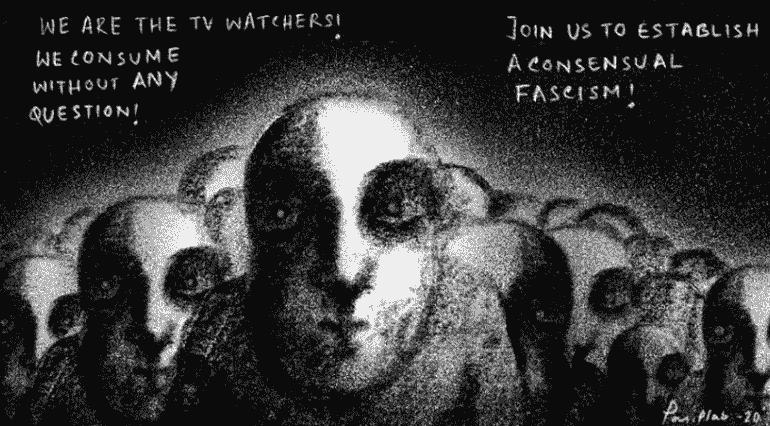Nationalism. The word reminds me of everything the nation stands for – the struggle that each martyr in the form of nationalists, protestors, and activists, has gone through for this country to get where we are today. It reminds me of artists like Faiz who sing of protest in their poetry: “bol ki lab azad hai tere” and activists like Hany Babu who continue to sing their songs of freedom. The flag then becomes a symbol of, not only the martyrdom, but the resistance against tyranny to uphold the country’s right ideals – a sovereign socialist secular democratic republic.
The revival of regressive forces has threatened the existence of Dalits, tribals, and minorities. With scant respect for democratic institutions and the Constitution, they seek to impose a crude exhibitionist form of nationalism. Patriotism is every citizen’s call of the soul. It’s not imposed, it’s a natural instinct.
– Kamala Shankar, 52
Nationalism or rashtravaad implies one’s loyalty towards their country or the sheer feeling of their devotion for the state surpassing any individual or collective interests. Patriotism refers to the love of one’s country, their unique identification and sense of attachment to the citizens sharing the same sentiment.
The pertinent question, then remains – when did nationalism start to imply love for the state or one’s government contrary to the love for one’s country? The dichotomies. The left-wing and the right-wing. Wokeness and ignorance. Facts and trolls. Duty and privilege. Where does it all end?
Conservatism or roodhivaad refers to upholding and promoting the tenets of traditional institutions and value-based systems, assuming that change is a gradual process and stability must remain intact. Chauvinism refers to the belief in the dominance of one’s own group or people; it can also be closely linked with xenophobia or inducing fear of the ‘other’ among the masses.
What then becomes imperative to understand is that one should refrain from gradually substituting the former with the latter. Nationalism, in its definition, is not vague but the blurring of boundaries takes root from xenophobia and hate speech. Declaring someone as an ‘anti-national’ has become as convenient as saying that nationalism in itself, both as an ideology and as a sentiment, remains exclusive. The mainstream nationalism is associated with a certain section of the society– the savarna upper-middle class male. If this holds true, then it all comes down to the point where you should ask yourself if you’re privileged enough to be a nationalist. As long as it doesn’t affect you, it becomes rather convenient believing or having faith in the mainstream media and WhatsApp University. But what does one do when it starts affecting their lives, their culture, their beliefs, and most importantly, their livelihoods?
If you are secular, you are anti-national. If you are secular, you are speaking the language of Pakistan. If you are secular, your patriotism is in question.
– P Chidambaram, Senior Congress leader
#Shoot is trending in India.
People asking the enforcement to stop the #FarmersProtest by shooting them.
— Ahmer Khan (@ahmermkhan) January 26, 2021
Dissent is equated with being anti-national and anti-Hindu. What the bigots fail to understand is that the ‘anti-national’s’ fight and struggle is not that of sovereignty but an attempt to hold on to their livelihoods. Thomas Jefferson said “When injustice becomes law, resistance becomes duty.” But to utter dismay, protestors in this country are labelled as “ignorant Khalistanis” or “jihadis” or even “terrorists”, causing public inconvenience while a tyrant or the oppressor continues to be the hero. Rabindranath Tagore in his letter to A.M. Bose in 1908 wrote that “patriotism cannot be our final spiritual shelter. I will not buy glass for the price of diamonds and I will never allow patriotism to triumph over humanity as long as I live”.
There is nothing wrong with having faith in the state’s rules and policies until the devotion transforms into obedience, thus ushering bhakti into politics. As one of the warnings posed by Ambedkar in his last speech to the constituent assembly, “Bhakti in religion may be a road to the salvation of the soul. But in politics, Bhakti or hero-worship is a sure road to degradation and to eventual dictatorship.” From a libertarian perspective, as long as the nation’s policies are meant to empower its people, and not the ones drafting it, we are in safe hands. But the moment it starts hurting socio-political, cultural, and religious sentiments of a particular community, it’s headed towards fascism or an oppressionist rule.
Bhakti in religion may be a road to the salvation of the soul. But in politics, Bhakti or hero-worship is a sure road to degradation and to eventual dictatorship.
– Ambedkar
Spreading hate speech and inducing fear in the minds of such dissenters, then, just becomes a desperate attempt to silence anyone and everyone who comes in the way of upholding the intricacies of this supposed normalcy.
@fayedsouza’s post from the events of 26 January, 2021
Within the bounds of law, liberal democracies ensure that citizens enjoy the right to express themselves in every conceivable manner, including the right to protest, and express dissent against prevailing laws. The blanket labelling of dissent as anti national or antidemocratic strikes at the heart of our commitment of the protection of constitutional values and promotion of a deliberative democracy.
– Justice Chandrachud, during a talk at the Gujarat High Court auditorium in Ahmedabad.
The nation has gradually managed to blur the notions of secularism and democracy in an attempt to homogenise the nation into a single identity to ultimately become a majoritarian rule. It’s time to block the dogma and let in the notions of liberalism or respect for each other’s opinions by indulging in constructive debates and criticism of the state’s rules and policies, thus inculcating the right kind of patriotism in promotion of inclusivity and sovereignty that present-day India should inherit.
Featured Image Credits: Pariplab Chakraborty (@pariplab_chakraborty)
Annanya Chaturvedi
[email protected]


